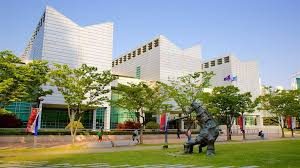2018 Busan Biennale
Divided We Stand
8 September – 11 November 2018
Venues: Museum of Contemporary Art Busan, The former Bank of Korea, Busan
Artistic Director: Cristina Ricupero
Curator: Jörg Heiser
The theme of this biennial is that of divided territories as it is reflected in artists’ work from around the world. Torn apart are not only territories – nations, or formerly ethnically connected regions, usually by war, colonization and/or hostile estrangement – but also, importantly, psyches.
What kind of sentiments and conditionings does the splitting of territories induce in people’s minds in general, and artistic minds specifically? Vice versa, what kinds of mindsets induce the splitting in the first place?
The secessions of territories and nation states are almost always a result of war, and colonialism; and as long as the partitions exist, there is a latent possibility that a dangerous conflict may always be on the horizon. Especially at times when populist politicians playing with fire have come to power in different parts of the world, that danger is imminent. Democratic and civil standards are under attack in many parts of the world; it’s hard to ignore the belligerent mood in many societies, fuelled by social media outrage, propaganda, but also the very real existence of corruption and exploitation. One could say that some characteristics of the Cold War era – an atmosphere of paranoia, and a taste for either/or, friend-or enemy antagonisms – are returning.
Politically and historically speaking, the list of divided territories or split former nation states, is long. Just talking about the globe after World War II, one can mention India, Pakistan Bangladesh; Congo and Sudan; Germany, former Yugoslavia, the former CSSR (now Czech Republic and Slovakia); the former Soviet Union, with all the secessions in the wake of its collapse; Ireland and Northern Ireland; Cyprus; China, Hong Kong and Taiwan; Indonesia and East Timor; Israel and Palestine; Kurdistan, as a territory split between numerous nation states; and not least, Korea.
Many artists have engaged with issues and themes connected to these divisions. However, the focus of the exhibition is not just on the documentary or fictional response artists have made to them. Crucially it looks at how souls are inspired, or haunted, by these political divisions.
We can connect the Cold War Era, for example, with feelings of paranoia, uncanny resemblance, and fear of the nuclear apocalypse: spies who came in from the cold, doppelgangers in ideology (think of the anti-communist McCarthy trials in the US as an echo of Stalinist show trials in the Soviet Union), and Godzilla monsters rising from the sea. In a multipolar world, after the Fall of the Berlin Wall and 9/11, it’s as if these split personalities or schizophrenic leanings of the Cold War era have been replaced with other, more complicated psychic conditions: multiple personalities, traumatically splintered, but also hybrid and multiplying. However, these notions stemming from psycho-analytic pathology are merely crutches to describe states of mind that can be very conscious and cultivated, not merely subconscious and driven.
Artists both are themselves informed by these conditions as well as they are responding to them in aesthetic form. Here, addressing the psycho-mapping of divided territories means to ask how the political, economic, and military powers have created ways to inhabit the world, and vice versa, how these ways either reinforce or erode these divisions. It also means to ask what struggles result from this relationship between psyche and territory, individual and community or people.
The exhibition will comprise both existing contemporary work – mainly of recent years, but also including select historical pieces – as well as a number of newly commissioned projects, in response to the exhibition theme, and current developments in different parts of the world. The approach shall be one of subtlety and nuance, exploring the contradictions of imaginative, psychic versus stern, factual readings of our world – not of broad-brush ideological polemics.
Busan Biennale 2018 will feature the work of around 60 artists all in all. Thinking of recent examples like Sculpture Projects Munster in Germany (35 artists) or the last Istanbul Biennale (55 artists), large scale, internationally renowned exhibitions have benefited from a reduction of the number of artists. Other large scale biennials and exhibitions run the risk of promoting a kind of megalomania of too many venues and artists.
We think the time of the mega-exhibition, exhausting even the most professional visitor with ever more venues and artworks, is over. Munster and Istanbul had a largely positive feedback not least because of their modesty in size, which also has the side-effect of making it possible to see everything within two or three days. But more importantly, themes and ideas have more time to grow on the viewers, as they are not forced to “consume” as many artworks as possible within the limited time of their visit. Also, reducing the number of artists has the effect that individual works are awarded more care and appreciation, both by staff as well as visitors.


